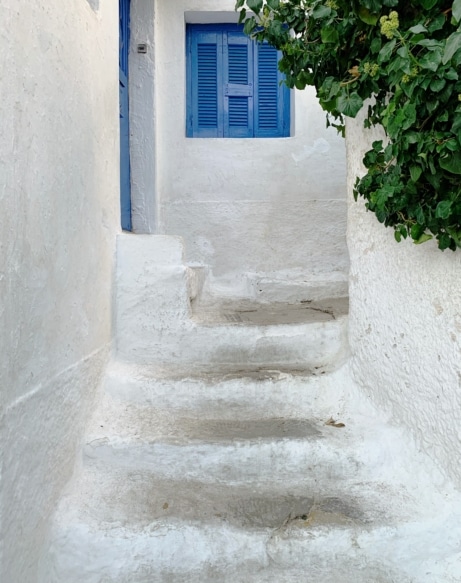Anafiotika: A Hidden Oasis in the Heart of Athens

Visitors to Athens will invariably spend much of their free time roaming the old town, or Plaka. This famed neighborhood is jam-packed with neoclassical buildings housing souvenir shops, restaurants and cafes, and conceals squares boasting remains of the millennia-old Greek civilization that most people visit the city to see. But there is a secret spot nestled between the Plaka’s main pedestrian street and imposing hill of the Acropolis above the old town that few get to, and that is even overlooked by many Athenians themselves. A tiny neighborhood that takes the lucky few who do stumble upon it on a journey to the whitewashed Cycladic Islands, and gives you the feeling of being lost in the backstreets of Santorini or Mykonos. That neighborhood is called Anafiotika, and it is truly a hidden oasis in the heart of the bustling metropolis.
The name Anafiotika, like most things Greek, has a history behind it. After Greece’s liberation from the Ottoman Empire in the 1830s, the first King of Greece, Otto I, set about creating a capital city out of what had essentially been reduced to a village. At that point, the city of Athens had only about 4,000 inhabitants, few houses and no real infrastructure. Otto called upon skilled workers from around the country to come help transform Athens into a capital city worthy of its historic splendor. The small Cycladic Island of Anafi had a reputation as home to some of the best stone masons, carpenters and skilled workers in the country, and it was only logical that these men and their families came to Athens in droves for the many projects that were being undertaken. As today, the center of the city of Athens was focused around the base of the Acropolis, so these tradesmen settled in an area on the northeastern slope that had not yet been built up. They hastily constructed houses in the style of their island: simple, thick-walled, whitewashed, cubic houses with colorful shutters clustered together and linked by narrow cobblestone streets. They called the area Anafiotika, or “little Anafi”, after the beloved island they had left behind, and a new Athenian neighborhood was born.

During the almost 200 years of the neighborhood’s existence, modern archaeology was born and the area around the Acropolis heavily excavated. Many of the original houses were pulled down during these excavations, so today fewer than 50 structures remain. They are almost all owned and inhabited by descendants of the original settlers from Anafi, and the law states that they cannot be sold: only passed down to family members or sold to the Greek state. The cobblestone streets connecting the houses have no street names, the houses being referred to as Anafiotika 1, Anafiotika 2 etc. for address purposes, so that a distinct village atmosphere pervades this unique corner of the city.
The neighborhood is hands-down one of my favorite spots in Athens for a number of reasons. It is quite literally a stone’s throw from the crowded Plaka, but the winding uphill paths that link it have no shops or cafes lining them, so most tourists stop and head back to where the action is. This means that you go from hustle and bustle to complete serenity within half a block. This residential area is quiet and cool in the summer’s heat, as the proximity of the houses coupled with the fact that most are decorated with brightly colored bougainvillea plants clinging to their dazzling whitewash make for shady pathways, some of which are wide enough for just one person to walk up or down at once. Every so often there is a break in the line of houses and you can see clear across the ceramic tiled roofs of the Plaka below clear across to Mount Lycabettus and beyond. The views from up here are gorgeous, especially in the early evening when the Athenian sky takes on shades of pink and purple, orange and gold. But the most alluring aspect of this neighborhood for me, is its ability to transport you to the islands, to another place and time at every turn. If you close your eyes on a summer’s evening and let your other senses awaken, you’ll hear the cicadas singing their summer song from the olive trees above you on the slopes of the Acropolis, smell the fragrant aroma of cypress and wild thyme, potted flowers and plants, feel the coolness of the shady alleyways even on the warmest of evenings, and almost taste the saltiness of the Aegean Sea, which although nowhere near you, feels like it can’t be that far away. And for the photography buff, the photo ops are just spectacular.

After walking around Anafiotika, you could head down into the Plaka for a bite to eat and some souvenir shopping. Or do what I do: take the Peripatos walkway that winds around the north slope of the Acropolis and ends at the foot of Mars Hill. Now climb up this rocky outcrop which was the seat of the Athenian Supreme Court when Athens was the world’s first fledgling democracy over 2,500 years ago: this is the spot for the best sunset views in Athens, and the place to watch the temples atop the Acropolis hill being lit up as dusk turns to night.










Anafiotika is definitely a magnificent, not-to-be-missed spot when visiting Athens–thank you for the wonderful reminder!
Sounds great! Maybe you can show us around sometime?
Inspiring! Mysteries and surprises still await us in Athens. Looking forward to trekking up those steps soon!
This will be a place that will not be overlooked on our next visit for sure.💕
Very good article. Nice to hear the story. My cousin in Greece told me the story. Our parents were originally from Anafi. It gives me a sense of pride to know how this tiny island contributed to the Acropolis.